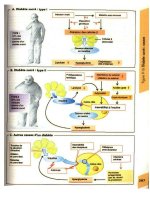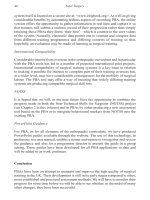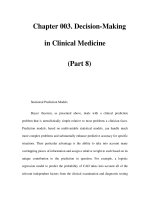Chapter 086. Breast Cancer (Part 8) docx
Bạn đang xem bản rút gọn của tài liệu. Xem và tải ngay bản đầy đủ của tài liệu tại đây (15.93 KB, 5 trang )
Chapter 086. Breast Cancer
(Part 8)
Table 86-3 Suggested Approaches to Adjuvant Therapy
Age Group
Lymp
h Node
Status
a
Endocr
ine Receptor
(ER) Status
Tum
or
Recommenda
tion
Premenopa
usal
Positi
ve
Any Any
Multidrug
chemotherapy +
tamoxifen if ER-
positive
+
trastuzumab in HER-
2/neu positive
tumors
Premenopa
usal
Negat
ive
Any >2
cm, or 1–
2
cm with
other poor
prognostic
variables
Multidrug
chemotherapy +
tamoxifen if ER-
positive +
trastuzumab in HER-
2/neu positive
tumors
Postmenopa
usal
Positi
ve
Negativ
e
Any
Multidrug
chemotherapy +
trastuzumab in HER-
2/neu positive
tumors
Postmenopa
usal
Positi
ve
Positive
Any
Aromatase
inhibitors and
tamoxifen with or
without
chemotherapy +
trastuzumab in HER-
2/neu positive
tumors
Postmenopa
usal
Negat
ive
Positive
>2
cm, or 1–
2
cm with
other poor
prognostic
variables
Aromatase
inhibitors and
tamoxifen +
trastuzumab in HER-
2/neu positive
tumors
Postmenopa
usal
Negat
ive
Negativ
e
>2
cm, or 1–
2
cm with
other poor
prognostic
variables
Consider
multidrug
chemotherapy +
trastuzumab in HER-
2/neu positive
tumors
a
As determined by pathologic examination.
Data on postmenopausal women are also controversial. The impact of
adjuvant chemotherapy is quantitatively less clear-cut than in premenopausal
patients, although survival advantages have been shown. The first decision is
whether chemotherapy or endocrine therapy should be used. While adjuvant
tamoxifen improves survival regardless of axillary lymph node status, the
improvement in survival is modest for patients in whom multiple lymph nodes are
involved. For this reason, it has been usual to give chemotherapy to
postmenopausal patients who have no medical contraindications and who have
more than one positive lymph node; tamoxifen is commonly given simultaneously
or subsequently. For postmenopausal women for whom systemic therapy is
warranted but who have a more favorable prognosis, tamoxifen may be used as a
single agent. Large clinical trials have shown superiority for aromatase inhibitors
over tamoxifen alone in the adjuvant setting. Unfortunately the optimal plan is
unclear. Tamoxifen for 5 years followed by an aromatase inhibitor, the reverse
strategy, or even switching to an aromatase inhibitor after 2–3 years of tamoxifen
has been shown to be better than tamoxifen alone. No valid information currently
permits selection among the three clinically approved aromatase inhibitors. Large
clinical trials currently underway will help address these questions.
Most comparisons of adjuvant chemotherapy regimens show little
difference among them, although small advantages for doxorubicin-containing
regimens are usually seen.









